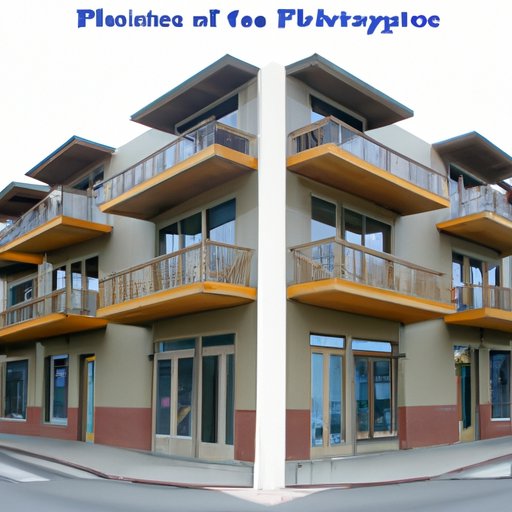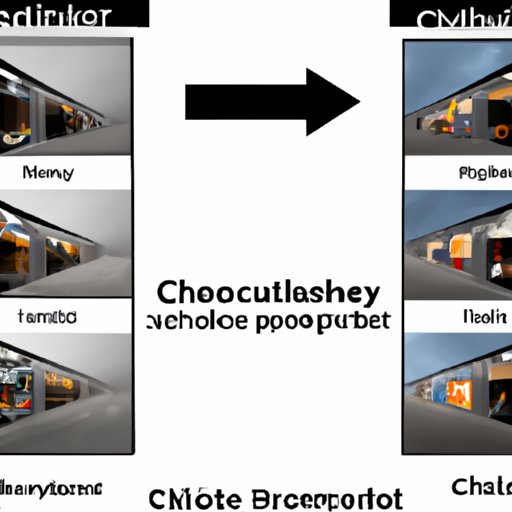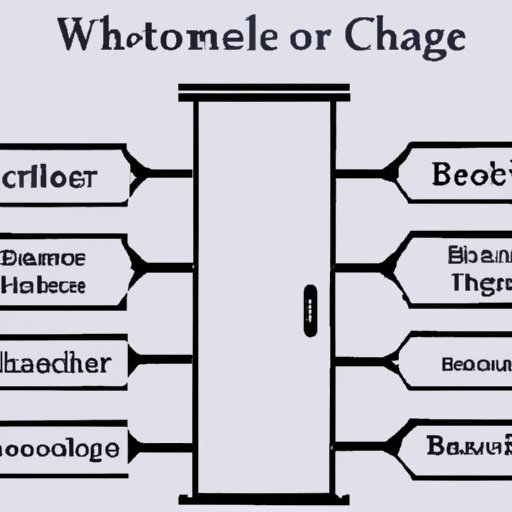Introduction
Choice architecture is an increasingly popular concept that has been gaining traction in the fields of economics, psychology, marketing, and business. The term refers to a set of techniques used to influence people’s decisions by altering the way choices are presented. This article will explore the concept of choice architecture and examine how it impacts decision making in everyday life.
Exploring Choice Architecture: What is it and How Does it Impact Decision Making?
Choice architecture is a field of study that examines how people make decisions and how those decisions can be influenced by the way options are presented. By understanding how people respond to different environments and stimuli, choice architects can design decision-making processes that lead to more desired outcomes. They use a variety of strategies to shape the decisions people make, such as presenting only relevant information, highlighting certain options, or framing choices in a particular way.
The goal of choice architecture is to create an environment where people are more likely to make the “optimal” decision, which typically means the decision that is most beneficial for them in the long run. This could mean choosing the healthier option over a less healthy one, investing in a retirement plan rather than spending money on luxuries, or selecting a more energy-efficient appliance. By understanding how people make decisions and designing an environment that encourages them to make better ones, choice architects can help people make decisions that are more beneficial to them.
Choice architecture is not limited to just influencing individual decisions; it can also be used to shape the overall environment in which decisions are made. For example, a choice architect might design a retail store to make certain products more visible or attractive to customers, or create a website that is easier to navigate and use. By creating an environment that encourages people to make better decisions, choice architects can have a significant impact on the decisions people make.
An Introduction to Choice Architecture: Understanding the Basics
When it comes to understanding choice architecture, it’s important to recognize the influences that can shape the decisions people make. These influences can range from subtle cues like the placement of items in a store, to more overt strategies like offering discounts or rewards. By understanding the influences that can shape decisions, choice architects can design strategies to lead people toward making better choices.
One of the major benefits of choice architecture is that it can help people make decisions that are more beneficial for them in the long run. For example, a choice architect might design a grocery store layout to encourage consumers to purchase healthier food items, or create a website that makes it easier for users to find the information they need. By understanding how people make decisions and designing an environment that encourages them to make better ones, choice architects can help people make decisions that are more beneficial to them.
However, there are also potential drawbacks to choice architecture. It can be difficult to determine the optimal choice in any given situation, and some people may view choice architecture as coercive or manipulative. Furthermore, if choice architecture is not implemented correctly, it can lead to unwanted outcomes, such as people making decisions that are not in their best interest. As such, it is important to understand the potential risks and benefits of choice architecture before implementing it.

How Choice Architecture Can Help Guide Decisions in Everyday Life
Choice architecture can have a profound effect on decision making in everyday life. For example, it can be used to create an environment that encourages people to make healthier choices when selecting food items at the grocery store, or to make more informed decisions when shopping for cars or other big-ticket items. Additionally, choice architecture can be used in the workplace to encourage employees to make better decisions about their work, such as taking regular breaks or engaging in team-building activities.
In addition to influencing individual decisions, choice architecture can also have an impact on the overall environment in which decisions are made. For instance, a choice architect might design a store layout to make certain products more visible or attractive to customers, or create a website that is easier to navigate and use. By creating an environment that encourages people to make better decisions, choice architects can have a significant impact on the decisions people make.
It is also important to consider the potential effects of choice architecture on consumer behavior. By understanding how people make decisions and designing an environment that encourages them to make better ones, choice architects can influence the decisions people make when shopping for goods or services. For example, a choice architect might design a website to make it easier for users to compare prices or features, or highlight specials or deals in order to encourage people to purchase a certain product or service.

The Impact of Choice Architecture on our Lives: Examining the Pros and Cons
When considering the impact of choice architecture on our lives, it’s important to evaluate both the positive and negative aspects. On the one hand, choice architecture can be beneficial in helping people make better decisions and creating an environment that encourages them to do so. On the other hand, it can also be seen as intrusive or manipulative, and if not implemented correctly, can lead to unintended consequences.
One of the major benefits of choice architecture is that it can help people make decisions that are more beneficial for them in the long run. For example, a choice architect might design a grocery store layout to encourage consumers to purchase healthier food items, or create a website that makes it easier for users to find the information they need. By understanding how people make decisions and designing an environment that encourages them to make better ones, choice architects can help people make decisions that are more beneficial to them.
However, there are also potential drawbacks to choice architecture. It can be difficult to determine the optimal choice in any given situation, and some people may view choice architecture as coercive or manipulative. Furthermore, if choice architecture is not implemented correctly, it can lead to unwanted outcomes, such as people making decisions that are not in their best interest. As such, it is important to understand the potential risks and benefits of choice architecture before implementing it.

Uncovering the Effects of Choice Architecture on Consumer Behavior
When it comes to understanding the effects of choice architecture on consumer behavior, there are a few key factors to consider. First, it is important to understand the various influences that can shape the decisions people make. These influences can range from subtle cues like the placement of items in a store, to more overt strategies like offering discounts or rewards. By understanding the influences that can shape decisions, choice architects can design strategies to lead people toward making better choices.
Second, it is important to consider the role of choice architecture in guiding consumer decisions. By understanding how people make decisions and designing an environment that encourages them to make better ones, choice architects can have a significant impact on the decisions people make when shopping for goods or services. For example, a choice architect might design a website to make it easier for users to compare prices or features, or highlight specials or deals in order to encourage people to purchase a certain product or service.
Finally, it is important to assess the effectiveness of choice architecture in guiding consumer decisions. By evaluating the results of choice architecture initiatives, it is possible to determine whether or not they are having the desired effect. Additionally, it is important to consider the potential risks and benefits of using choice architecture, as well as the potential unintended consequences.
Analyzing Choice Architecture: A Comprehensive Guide
When analyzing choice architecture, it is important to understand the different types of choice architecture and how they can be used to influence decision making. There are many different types of choice architecture, ranging from simple tactics like offering discounts or rewards, to more complex strategies like changing the way choices are framed or presented. By understanding the different types of choice architecture, it is possible to identify which techniques are most effective in a given situation.
Additionally, it is important to examine the impact of choice architecture on decision making. By understanding how people make decisions and designing an environment that encourages them to make better ones, choice architects can have a significant impact on the decisions people make. It is also important to consider the potential effects of choice architecture on consumer behavior, as well as the potential risks and benefits of using choice architecture.
Finally, it is important to apply choice architecture principles to real-world problems. By understanding how people make decisions and designing an environment that encourages them to make better ones, choice architects can help people make decisions that are more beneficial to them. By understanding the different types of choice architecture and how they can be used to influence decision making, it is possible to develop strategies that can help people make better decisions in their everyday lives.
Conclusion
Choice architecture is an increasingly popular concept that has been gaining traction in the fields of economics, psychology, marketing, and business. The goal of choice architecture is to create an environment where people are more likely to make the “optimal” decision, which typically means the decision that is most beneficial for them in the long run. Choice architecture can be used to influence individual decisions, as well as the overall environment in which decisions are made. Additionally, it can have a significant impact on consumer behavior, as well as the potential risks and benefits of using choice architecture.
By understanding the different types of choice architecture and how they can be used to influence decision making, it is possible to develop strategies that can help people make better decisions in their everyday lives. Furthermore, it is important to consider the potential effects of choice architecture on consumer behavior, as well as the potential risks and benefits of using choice architecture.
Overall, choice architecture can be a powerful tool for influencing decision making and creating an environment that encourages people to make better choices. By understanding the basics of choice architecture and applying it to real-world problems, it is possible to design strategies that can help people make better decisions in their everyday lives.
(Note: Is this article not meeting your expectations? Do you have knowledge or insights to share? Unlock new opportunities and expand your reach by joining our authors team. Click Registration to join us and share your expertise with our readers.)
